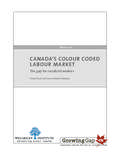On the International Day for the Elimination of Racial Discrimination a new report by the Wellesley Institute and the Canadian Centre for Policy Alternatives reveals that despite an increasingly diverse population, Canada’s racialized income gap shows a colour code is still at work in Canada’s labour market.
Canada’s Colour Coded Labour Market draws on 2006 Census data to compare work and income trends among racialized and non-racialized Canadians. It’s among the more comprehensive post-Census studies on this issue to date.
“We found that during the heyday of Canada’s pre-recession economic boom, racialized Canadians were more willing to work, but experienced higher levels of unemployment and earned less income than non-racialized Canadians,” says co-author Grace-Edward Galabuzi, CCPA board member and Ryerson University professor. “The distribution of work tells a disturbing story: Equal access to opportunity eludes many racialized Canadians.”
Co-author Sheila Block, Director of Economic Analysis at the Wellesley Institute, says racialized Canadian workers earned only 81.4 cents for every dollar paid to non-racialized Canadian workers – reflecting barriers in Canada’s workplaces.
“The work racialized Canadians are able to attain is more likely to be insecure, temporary and low paying,” Block says. “Despite an increasingly diverse population, a colour code is firmly in place.”
Among the study’s findings:
• In 2006, during the boom years, racialized Canadians had an unemployment rate of 8.6 per cent, as compared to 6.2 per cent for non-racialized Canadians.
• On average, non-racialized Canadian earnings grew marginally (2.7%) between 2000-2005 – tepid income gains considering the economy grew by 13.1%. But the average income of racialized Canadians declined by 0.2%.
• Racialized workers are over-represented in industries with precarious low-paid jobs; they are under-represented in public administration, and more likely to work in the hard-hit light manufacturing sector.
• The colour code contributes to much higher poverty levels: In 2005, 19.8% of racialized families lived in poverty, compared to 6.4% of non-racialized families.
Download the report here.
